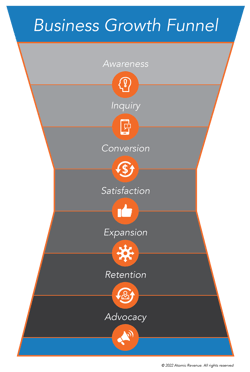.png?width=906&height=475&name=Atomic%20Revenue%20Blog%20Headers%20and%20Graphics%20(13).png) Revenue operations focuses on the profitability outcomes that a business is trying to achieve. Most business leaders get revenue operations wrong – they think too narrowly about what it actually entails. The oversimplification of revenue operations limits profitability and impedes growth for any type or size of B2B company.
Revenue operations focuses on the profitability outcomes that a business is trying to achieve. Most business leaders get revenue operations wrong – they think too narrowly about what it actually entails. The oversimplification of revenue operations limits profitability and impedes growth for any type or size of B2B company.
- Is revenue operations sales operations? Business operations?
- Is revenue operations new technology or your MarTech stack?
RevOps is not focused exclusively on revenue, technology, marketing, sales operations, sales enablement, business operations, digital operations, or finance. Revenue Operations is the sum of all the parts of a business that come together to create an exceptional buyer journey, requiring full alignment of people, process, technology, and data.
But what exactly does this definition mean? Keep reading to learn what everyone’s getting wrong about revenue operations, what true RevOps is, and why getting it right matters.
Is Revenue Operations Sales Operations?

Business leaders are so focused on revenue, they think RevOps is really sales operations dressed up in fancy words. Others say revenue operations is sales enablement and sales validation. Sales ops, sales enablement, and sales validation typically involve the marketing department, which leads some executives to clump marketing into their definition of revenue operations.
Companies that take a sales-operations approach to revenue cut a thin slice out the middle of the seven-stage buyer journey (see the Business Growth Funnel) and focus exclusively on how sales operations impacts revenue growth. The wrong perspective here is that making changes to how sales happen and giving a nod to marketing’s role in that process does not mean that you are now “doing” revenue operations.
Yes, sales operations is a very important part of RevOps, but it’s only one small piece of a much bigger puzzle.
Is Revenue Operations New Technology or Your MarTech Stack?
Some companies look at revenue operations as technology. Business leaders may look at lead-to-cash from a technology standpoint, a business process standpoint, or a financial standpoint. This can go very wide in the seven-stage buyer journey, but it's still very shallow because it only includes individual pieces instead of how all the parts fit together. Technology alone does not lead to profitable revenue growth.
- Revenue operations is not just a MarTech.
- Revenue operations is not just a CRM or an ERP.
- Revenue operations is not just a digital transformation to do the same things in a new way.
- Revenue operations is not just new technology and automation that improves processes.
When a company looks at improving a business operations function, a sales function, or a marketing function with technology, often the technology solution is built for the process or the data instead of as a tool that distributes responsibility and empowers their people to make decisions that positively affect the customer experience.
Technology built to improve the entirety of revenue operations integrates data and systems throughout the company to facilitate a scalable, consistent, and successful customer journey from awareness through delivery and beyond to customer advocacy.
Technology solutions for RevOps should be easy to use (if unused, the revenue operations process dies immediately) and easy to understand so people can maximize their job functions while facilitating the ideal customer experience. The right technology will enhance your process and provide meaningful data and KPIs to your people, so they can continue to improve and manage activity as they care for a higher volume of high-quality customer experiences. More on data a little later.
.png?width=1200&height=629&name=Atomic%20Revenue%20Blog%20Headers%20and%20Graphics%20(14).png)
What is Revenue Operations?
We’ve talked about what revenue operations is not. So, what is revenue operations?
Revenue operations is both deep and wide. It is how, without departmental siloes and with personal accountability, all your people, process, technology, and data work together to produce measurable outcomes in lead generation, sales conversion, and customer advocacy.
There are 130 elements in the revenue operations process, each essential to a customer-advocacy focus and long-term profitability.
Your go-to-market strategy, lead generation, sales conversion, customer advocacy, business operations, digital operations, and financial operations must all work together to complete the buyer journey successfully.
Most companies make the mistake of only changing or improving one or two processes (usually sales and marketing), when it may be twenty different elements in the RevOps process slowing progress in reaching their growth potential.
For example, if you build a great product but can’t get it to the customer in a timely fashion, revenue will be affected. If you get a customer excited to buy, but can’t present a contract with terms that they’re willing to sign, you can’t get revenue. If your customer acquisition costs are too high, then the revenue from this process is not valuable to the business because there are inadequate profit margins.
When your RevOps focus is too narrow or too shallow, you likely make changes to only one element (for example, how messaging is delivered or how technology helps salespeople manage customers), which cannot solve your revenue issues.
Now, we’ve talked about process and technology as they relate to revenue operations, but the most significant two remaining factors of revenue operations have yet to be examined – people and data. You simply can’t grow profitably without them.
.png?width=906&height=475&name=Atomic%20Revenue%20Blog%20Headers%20and%20Graphics%20(16).png)
People Operations as Part of Revenue Operations (RevOps)
Let’s look at the “people” part of revenue operations because your internal customers (the people) make business possible.
When the people in your organization understand their role and the purpose of their work related to the customer experience; when teams understand how their work impacts the success of their team members who carry the next responsibility, and everyone is speaking the same language on the same mission for customer success, then more high-value customers can have a positive experience working with your company.
Distributed accountability puts the responsibility for improving the customer experience onto individuals and improves how multiple departments work together in serving the customer, reducing manager involvement by empowering self-managed teams.
It is also imperative that throughout the revenue operations process, the entire company is communicating in the same way, in the same style, and on-brand, so each customer doesn't feel like they've talked to two or three different people at a company. Cross-functional teams working together facilitate the best customer experience possible and allow you to scale operations.
- Distributed Accountability breaks down silos and establishes peer-to-peer accountability relationships in every layer of a company, across all departments.
- Smooth customer handoffs between your people make for a seamless customer experience.
- Cohesive communication and messaging throughout the company build your brand and create an enjoyable internal and external customer experience.
- When your internal customers become raving fans, they help you fill open positions and publicly advocate for your brand, both crucial for profitable growth.
I realize this may seem somewhat unrealistic, but … it is possible to hire and retain highly productive and happy internal customers by giving them access to meaningful data that empowers them to make great decisions that drive great business outcomes.
.png?width=906&height=475&name=Atomic%20Revenue%20Blog%20Headers%20and%20Graphics%20(17).png)
Data as Part of Revenue Operations (RevOps)
At Atomic Revenue, we talk a lot about the importance of being data-driven. That’s because, without good data, you just have a lot of people making critical decisions based on their opinion.
Using good data as part of revenue operations is different than paying attention to vanity metrics or departmentalized data, both of which are common data missteps that lead to wasted time, misallocated resources, and unnecessary costs.
True revenue operations empowers people to make decisions with data as their guide. Data helps them understand how they are responsible for impacting the buyer journey in measurable, quantifiable ways.
Powerful data points, or Key Performance Indicators (KPIs), when compiled into a high-functioning dashboard, deliver maximum value quickly and inform you about business progress without requiring much, if any, additional interpretation or calculation. Leveraging the right data helps everyone make smart business decisions and achieve profitable growth.
In true revenue operations, the data is aggregated across all stages of the buyer journey and across all departments to measure:
- Process efficiency and effectiveness
- Revenue and profitability performance
- Quality and value of customer experience
“Insight-based data can unlock the power to control customer satisfaction and turn it into advocacy, which helps acquire new customers with ease and change your team culture. In fact, according to PWC, 73% of all people point to experience as an important factor in their purchasing decisions,” said Roger Bielicke, Executive Partner, Atomic Revenue.
.png?width=906&height=475&name=Atomic%20Revenue%20Blog%20Headers%20and%20Graphics%20(18).png)
Revenue Operations is a Complete Business Strategy that Focuses on the Customer
Over many years, Atomic Revenue’s experience supporting our B2B clients with revenue operations solutions confirms that success comes from the alignment of a company’s people, process, technology, and data in a way that supports the buyer journey.
Businesses thrive when customer advocacy is the focus. And to achieve productive customer advocacy, the 130 elements within revenue operations must be assessed, and the issues that impede your customer experience and scalability must be resolved.
When you operate with a highly functional revenue operations strategy to convert prospects into happy customers, add a little extra care to keep them happy, retain them, inspire them to buy again and tell others about you, the results will be reflected in your revenue.
Let Atomic Revenue Launch Your Company’s Growth with Revenue Operations
If you’re ready to develop and implement a revenue operations strategy that drives the right decisions so your people can collaboratively achieve the desired business outcomes, let us know. Our nationwide team of subject matter experts is here to help your business succeed with revenue operations solutions that launch measurable growth. Contact us for a no-obligation conversation.
 About the Author
About the Author
Tara is the Owner and CEO of Atomic Revenue, where she continues to problem-solve, innovate, and define the formula for and establish the discipline of revenue operations that launches client growth with stronger foundations and better ROI. As the company's EOS® Visionary, it is her passion to share what she has learned over the course of her career and help other business owners and leaders increase revenue and grow with consistency. She is also a renowned national speaker.





